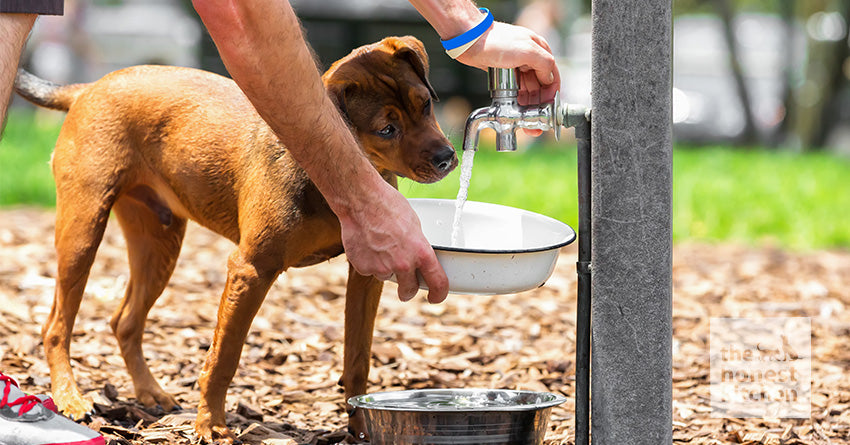Have you ever found yourself refilling your dog's water bowl more often than usual? It's a common scenario that can raise some important questions. Is this newfound thirst something temporary, or could it be a sign of a deeper health issue?
It's crucial to recognize when increased thirst might warrant a closer look. While it’s often perfectly normal for dogs to drink water — especially after physical activity or in warm weather — a sustained change in drinking habits can be a red flag.
In this blog, we'll explore the potential causes behind your dog's increase in thirst and when it might be time to consult a vet for professional advice. While proper nutrition from The Honest Kitchen can provide a solid foundation for your pet's health, it's important to address specific health concerns like excessive thirst with your veterinarian.
So let's dig into the reasons your dog might be making extra trips to the water bowl, and what to do about it.
How Much Water Should a Dog Drink Each Day?
First things first, let's establish a baseline for how much water your dog should be drinking under normal circumstances. On average, a healthy dog should drink about one fluid ounce of water per pound of body weight each day. If you're more comfortable with metric units, that translates to around 40 to 50 milliliters per kilogram.
However, these numbers aren't set in stone. Several factors can influence your dog's hydration needs. Here's a quick rundown:
Weather
During hot or humid conditions, your dog might need extra water to stay cool and hydrated. Conversely, in colder climates, the water requirement might be slightly less.
Activity Level
A dog that has been sprinting around the park is naturally going to need more water compared to a lazy day on the couch. Keep an eye on their water bowl more diligently after strenuous activities.
Remember, these are general guidelines. For a tailored hydration plan, especially if you've noticed a persistent increase in thirst, consulting your veterinarian is the wisest course of action. They can offer specific advice based on your pet's unique needs and lifestyle.
Should I Be Worried If My Dog Is Drinking More Water Than Usual?
If you've observed that your dog's water bowl is emptying faster than usual, it's natural to feel concerned. But before you jump to any conclusions, there are some key factors to consider:
Temporary Changes
Have there been any recent changes in your dog's environment or routine? If it's an unusually hot day or they've been more active, that could explain the increased water intake.
Diet
Did you recently switch their food? Some foods, particularly those with higher salt content, can make your dog thirstier than usual.
Behavior
Are there any other changes in behavior? Aside from excessive drinking, look out for signs such as lethargy, loss of appetite, or more frequent urination.
Duration
How long has this increased thirst been going on? If it's just a day or two, it may not be a cause for concern. However, if this has been a consistent pattern for over a week or more, it could be indicative of an underlying cause.
If you're still unsure, or if you've observed a sustained increase in your dog’s thirst along with other behavioral changes, it's advisable to consult your veterinarian. They can perform tests to rule out any potential life-threatening health problems, such as diabetes or kidney failure.
What Could Cause My Dog To Drink So Much Water?
So you've noticed your dog's water bowl is emptying quicker than usual, and you're wondering what could be the cause. While this increased thirst could be due to various factors, it generally falls into three main categories: environmental, medical, and dietary. Let's explore each one.
Heat and Exercise
If your dog has been more active than usual or the weather has been especially hot — your dog will naturally need lots of water to stay hydrated and cool. This extra water consumption is their body's way of regulating temperature and replenishing lost fluids.
In these situations, an increased thirst is not only normal but healthy. It shows that your dog's body is responding as it should to external conditions.
Medical Conditions
Sometimes, the reasons behind excessive thirst and urination are more complicated and could point to an underlying medical condition. Here are some causes of your dog drinking more water than usual:
- Endocrine disorders: Hormonal imbalances can affect water regulation in the body, leading to increased thirst.
- Urinary tract infection (UTI): A UTI can make your dog feel the need to drink and urinate more frequently.
- Cushing’s disease: This disorder results from an excess of the hormone cortisol, leading to symptoms that can include increased thirst and excessive urination.
- Cancer: Some forms of cancer may cause increased thirst as the body tries to fight off the disease.
- Liver disease: Liver function is crucial for overall metabolism, and when it's compromised, it can lead to increased thirst.
- Gastrointestinal issues: Conditions like inflammatory bowel disease can make your dog feel thirsty more often.
- Chronic kidney disease: Kidneys play a significant role in fluid balance, and disease here can lead to excessive thirst.
- Diabetes mellitus: High blood sugar levels often lead to increased thirst and frequent urination.
- Certain medications: Steroids and some other medications can also cause increased thirst.
For most of these health conditions, you'll also notice that your dog may be peeing more frequently. If you're observing a sustained change in water consumption, coupled with other symptoms, consult your veterinarian immediately for diagnosis and treatment.
Diet Considerations
Last but not least, let's talk about diet. If your dog's menu consists mainly of dry food, that could be a culprit.
Dry foods often have less moisture content, making your dog seek extra hydration elsewhere. You might notice your pup hitting the water bowl more frequently if dry kibble is their primary source of nourishment.
Remember, unless your dog has been diagnosed with a disorder that requires monitoring water intake, you generally don't need to measure every ounce they drink.
Quality nutrition, like human grade food offered by The Honest Kitchen, can help maintain your dog's overall well-being. However, if you’re considering changing your dog’s diet due to excess thirst concerns, it’s best to consult your veterinarian first.
What Happens When a Dog Drinks Too Much Water?
Sometimes, when a dog drinks an excessive amount of water, it can lead to a condition known as water intoxication. This can happen inadvertently during activities like playing fetch at a lake or any water-based game.
In these situations, dogs may ingest more water than they intend to. This excess water intake can be problematic because it displaces essential electrolytes — primarily sodium — leading to strain on vital organs, including the brain, which can result in brain swelling.
When a dog is affected by water intoxication, they may exhibit noticeable signs such as lethargy, reduced responsiveness, and neurological symptoms. In some cases, they may even appear as if they're intoxicated, stumbling, or having difficulty moving correctly. If you notice any of these signs in your dog, be sure to contact your vet immediately.
Signs of Dehydration in a Dog
Recognizing the early symptoms of dehydration can help you act promptly and ensure your dog gets the care they need. Here's what to look out for.
Low Activity Level
If your dog is unusually lethargic and shows little interest in activities they usually enjoy, it could be a red flag for dehydration. Energy levels often dip when a dog's body is struggling to maintain its fluid balance, making them less playful and active.
Droopy Ears
Another subtle but telling sign of dehydration is droopy ears. Ears that usually stand erect or perky may start to look unusually droopy when a dog is low on fluids.
It's not just the eyes that are the windows into a dog's health; sometimes, it's the ears, too!
Thick and Stringy Drool
Drooling is common among dogs, but the texture and consistency can indicate hydration levels. When a dog is dehydrated, their drool can become thick and stringy instead of watery.
You can also check your dog's gums. Healthy gums should be moist and pink; if they feel sticky, it's often a sign of dehydration.
Lack of Elasticity in the Skin
Skin elasticity is a quick and straightforward way to check for dehydration. To perform this test, gently pinch the skin behind your dog's shoulders and release it. In a well-hydrated dog, the skin will quickly return to its normal position. If it takes longer, it's often an indication that your pet needs more fluids.
Tips for Supporting Healthy Hydration in Your Dog
By now, you probably have a thorough understanding of how crucial proper hydration is for your dog's health. But how can you actively support your pup in maintaining healthy hydration levels? Here are some essential tips that go beyond merely refilling the water bowl.
Never Try To Limit a Dog's Water Intake
First things first: never attempt to limit how much water your dog drinks unless instructed by a veterinarian.
Dogs instinctively know how much water they need and will self-regulate their intake to maintain proper hydration — just like you. Restricting their water can cause unnecessary stress on their system and lead to dehydration.
So, unless your dog has a diagnosed medical condition that requires monitoring, let them have free access to the water bowl.
Always Provide Water for Your Dog When Leaving Home
Whether you're heading out for a quick walk or a long drive, it's essential to pack some water for your dog. Unexpected delays or hot weather can make your dog thirstier than usual. Having water on hand ensures they stay hydrated, no matter the circumstances.
Frequently Change Their Water So It’s Fresh
Just like humans, dogs prefer fresh, clean water. Make it a habit to empty and refill your dog's water bowl regularly. Stale or dirty can be less appealing, which might discourage your pup from drinking water as much as they should.
Always Offer Water at the End of an Activity
After playtime, a walk, or any form of exercise, it's crucial to offer your dog water. Activities use up energy and can make your dog pant more, leading to a loss of moisture. Rehydrating after exertion helps in faster recovery and keeps your dog energized for the next round of fun.
Support Your Pup's Hydration With Dog Food from The Honest Kitchen
Hydration is more than just about the water bowl; it's an integral part of your dog's overall well-being. From recognizing signs of dehydration to maintaining regular water access, being proactive can make a world of difference.
And when it comes to keeping your pup hydrated, wet and dehydrated foods are game changers. The Honest Kitchen offers an array of wet and dehydrated options that are not only packed with human grade, whole-food ingredients but also contribute to your dog's hydration.
With dehydrated food, you can add more or less water or broth to adjust to your dog’s liking and hydration needs. You can even pour our wet toppers over dry food as a delectable gravy, or use it to rehydrate an Honest Kitchen meal to make dinner even more richly flavorful.
Ready to up the hydration game for your pup? Check out The Honest Kitchen’s wet food collection and find a recipe your dog will love, all while supporting their hydration needs.
*Health Disclaimer: This post is educational in nature and doesn’t constitute health advice. Please consult your pet's veterinarian or other healthcare professional for specific guidance on this topic.
